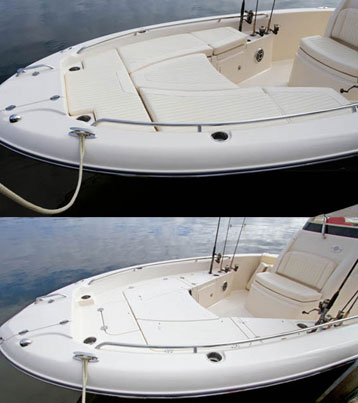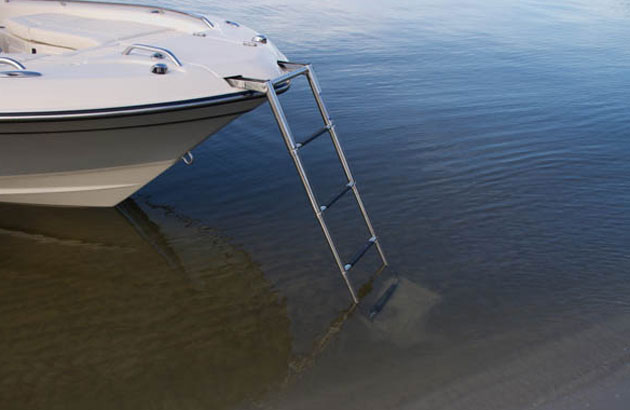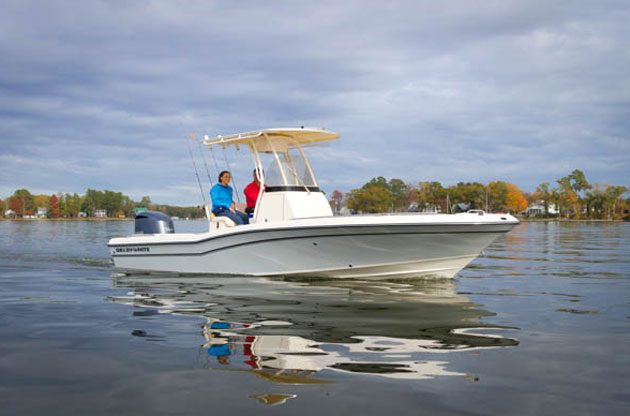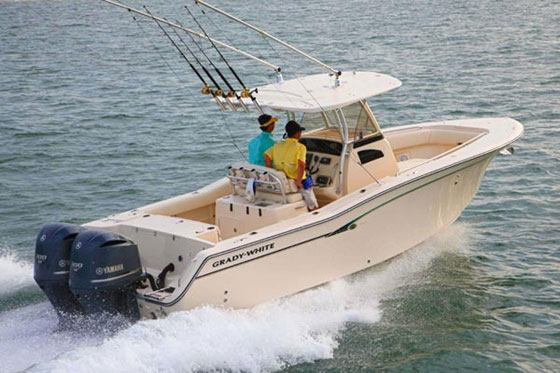Grady-White 251 Coastal Explorer: Bay Boat Review
The first bay boat ever from the iconic fishing boat builder Grady-White, the 251 Coastal Explorer, is ready for a casting call.
Bay boats have become amazingly popular over the past decade, and with the 251 Coastal Explorer, Grady-White has entered the fray. This marks a new direction for this well-known builder, which has spent the past few years developing its line of large dual console cruisers, like the Freedom 335. And it’s a direction we anglers in search of finning redfish and hungry speckled sea trout like.
Cap and Trade
Bay boats have to walk a narrow line; shallow draft is important so you can sneak into back-country channels and cuts, but the hull needs enough V (which increases draft) to smooth out the ride. Fore and aft casting decks are imperative, but everyone still wants enough seating to take the entire family for a ride. And low sides are a must for easily landing the fish, but if they’re too low, you won’t be able to pop through the inlet for an oceanic adventure when the weather allows. In short, bay boats are a case study in boat design compromises, and looking at the 251 Coastal Explorer from a few different angles helps you understand how and where Grady-White’s designers made those compromises to create a big, beefy bay boat that can still get into and out of the shallows. First, consider the side profile above. Note that the aft gunwales sit rather high for a bay boat, and the bow is even higher. Clearly, Grady-White tilted towards big-water seakeeping abilities in this regard. Yes, you will have to lean a bit farther to scoop a fish with the net, or lift a little higher to swing a fish over the gunwales. But on the flip side you won’t hesitate to run this boat offshore, which plenty of bay boats with very low profiles simply aren't capable of.
You can learn more from the aft view. Yes, this hull clearly has some V in it, again showing Grady-White’s intent to make the 251 competent in big seas. Transom deadrise is 16-degrees, which is well shy of a deep-V hull but is still on the steep side for bay boats, which commonly range from 12 to 16 degrees. Now, let’s take a look from overhead.
Notice that the bowdeck is notched in a huge way, and the aft deck is eaten up with seating. These attributes should cut into the boat’s fishing ability, while providing better family/pleasure usability. And as you see the boat in this illustration, perhaps they do. But Grady-White addressed them with some smart design tweaks that overcome the fishy-or-family conundrum. Those aft seat backrests fold completely flat, turning the aft deck into an uninterrupted casting arena. And up front, there’s a filler platform—which does double-duty as a forward cockpit table—that locks into the foredeck. Put it in place, get rid the table pedestal and all those poofy cushions (which also allow you to turn the entire foredeck into a sunlounge), and you have an A-rated forward casting deck.

The bowdeck of the 251 CE, in both cushioned and fishing-ready incarnations, with the filler platform in place.
The only real down-side to this arrangement is that you’ll have to do some prep work prior to your trip to convert the 251 from a die-hard angling machine into a family cruiser, or vise-versa. No biggie—I went through the entire process, and it took about 10 minutes.
Reel Performance
Once you have the 251 Coastal Explorer rigged and ready as needed, you’re ready to pour on the coals, and get to where you’re going. With a Yamaha F300 on the transom, you can expect to get there at about 38 mph (and getting about 2.6 miles to the gallon) while cruising in the 4500 RPM range. If you’re in a big rush, firewall the throttle and you’ll be running darn close to 50 mph. Rigging with an F250 is also an option, which will tick back speeds by four or five mph without affecting fuel economy much at all. Since there isn't a real savings savvy buyers will go with the F300; rigging with maximum power usually increases a boat’s resale value and makes it easier to find a buyer when you're ready to sell.
It's time to to fish? There’s an optional aft livewell which is, IMHO, marginal for serious anglers. It’s lighted and has a full column inlet, but only holds 12.75 gallons. That makes the optional leaning post, which houses a 25 gallon livewell, a must-have item. You’ll want that leaning post anyway, since it gets you four rocket launchers to go along with the four aft rodholders and six vertical forward rodracks. Another must-have option is the raw-water washdown. Once your livies get snapped up, there’s plenty of insulated, integrated fish stowage in a pair of 74-quart forward boxes, and a 51 quart aft fishbox.
At this time Grady-White doesn't offer a factory-installed Power Pole, so you’ll have to get your dealer to do the job. Same goes for a bow-mounted trolling motor though Grady does offer trolling motor rigging, again as an option.
Reelaxation
The 251 Coastal Explorer also has a few extra cards up its sleeve when it comes to family time on the water. Taking a page out of the deckboat playbook, Grady White incorporated a bow boarding ladder where you expect to find a mere anchor locker.

The bow boarding ladder is a big plus for afternoons at the beach, since you don’t have to get on and off the boat at the stern, in deeper water.
Another nifty feature is that forward cockpit table/foredeck filler, which serves a third role as a lounger. Put it on the table pedestal, lower it to the height of the forward console seat, and you have another comfy place to stretch out. But the biggest family perk is, without question, the console head compartment—something few bay boats provide.
| Specifications | |
|---|---|
| Length | 24'7" |
| Beam | 8'6" |
| Draft (hull) | 1'2" |
| Deadrise | 16 degrees |
| Displacement | 3,550 lbs |
| Fuel capacity | 78 gal. |
| Water capacity (optional) | 10 gal. |
What about construction quality? No worries, here. If you've been on a Grady-White before you won’t be surprised to discover a fit and finish that sweats the details, copious use of 316-grade stainless-steel (even for the cupholders), and closed-cell polyurethane foam floatation filling the belowdecks voids. You also won’t be surprised to learn that boats built this way don’t come cheap; base MSRP on the 251 is just a few grand under $100K at the time of publication and when you add on all the options you need, you can expect that $100K barrier to be broken. One thing that may surprise you, however, is the extensive use of thick Starboard as a construction material in the seat-backs. Many builders would use less expensive ABS plastic or roto-molded plastic in this application, which would be more prone to failure.
| Performance Data | |||
|---|---|---|---|
| Test conditions: calm seas, winds 5 knots, 2 POB. Performance data courtesy of Yamaha. | |||
| RPM | MPH | GPH | MPG |
| 1500 | 7.4 | 2.2 | 3.4 |
| 2000 | 8.6 | 3.4 | 2.6 |
| 3000 | 22.6 | 6.4 | 3.6 |
| 4000 | 34.4 | 11.3 | 3.1 |
| 5000 | 43.2 | 19.8 | 2.2 |
| 5800 | 49.6 | 26.6 | 1.9 |
| Power | Single Yamaha F300 four-stroke outboard, swinging a 15.25" x 18" three-bladed stainless-steel prop. | ||
Building a bay boat may be a new endeavor for Grady-White, but if history is any indication, there’s a good chance Grady will make it standard practice. We asked our contacts at the factory if additional sizes of the Coastal Explorer would be introduced in the future and they remained closed-lipped, but there’s at least one hint we can take: on their web site “Coastal Explorer” is listed as a series, with the 251 as a model. The last time we saw that happen, the Dual Console line-up exploded to its current size of nine offerings ranging from 19 to 37 feet. And in any case the 251 is here to stay, so you bay boat lovers can rest at ease—unlike those redfish and speckled sea trout.
Other Choices: Another beefy bay boat with top-notch fit and finish is the Pathfinder 2600 Bay Crusher. This boat places more of an emphasis on pure fishing and doesn't have family touches like the console head or extra seating, but it also goes faster with a cruise in the low 40’s and a top-end of 61.9 mph. A slightly smaller, less expensive option would be the Sea Hunt 24 BR.
See Grady-White 251 Coastal Explorer listings.
For more information, visit Grady-White.




















